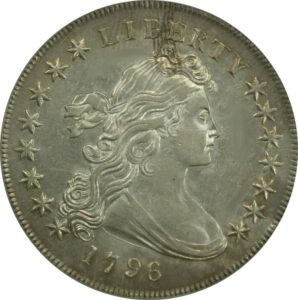
Coin Snapshot
- Weight: 26.96 grams
- Composition: 90% silver, 10% copper
- Diameter: 39-40 mm
- Thickness: Varies
- Years Minted: 1795-1803, *1804
- Designed by: *Gilbert Stuart / Robert Scot
- Total Coins Struck: 1,439,290 (combined Small and Heraldic Eagle designs)
*The designer of the Draped Bust Dollar was never officially acknowledged, however, it is widely believed that Gilbert Stuart was the original designer of the coins.
The Draped Bust Dollar was minted for circulation by the United States from 1795 to 1803, and then re-issued from 1834 through the 1850s. The coins that were struck from 1804 onwards all feature an 1804 date on them, as there was a misunderstanding from mint officials that this was the last year the coin was previously minted (rather than 1803). Coins dated 1804 are extremely rare, and it was last believed that only around 15 examples of these coins are still in existence.
The Draped Bust Dollar succeeded the Flowing Hair Dollar and is one of the earliest silver coins produced by the U.S. Mint. The Draped Bust design marked a significant improvement in the aesthetic quality of U.S. coinage, reflecting the nation’s desire to enhance its public image and produce coins that rivaled those of European nations. These coins are highly sought after today due to their historical importance and rarity, making them a centerpiece of early American numismatics.
The Draped Bust Dollar is a significant artifact from the early years of the United States, symbolizing the nation’s development of its monetary system and its quest for international recognition. Collectors prize this coin for its age, beauty, and the fascinating period it represents.
Draped Bust Dollar Coin Design
Though the true designer of the coin was never publicly released, it was later revealed that the most likely designer was Gilbert Stuart. It is also believed that a Philadelphia socialite of the time, Ann Willing Bingham, posed for Stuart as the model for the design on the obverse of the coin. Several of the sketches featuring Bingham were approved by the mint engraver of the time, Robert Scot. They were then sent to President George Washington and Secretary of State Thomas Jefferson, where they were quickly approved.
Obverse Design
The obverse of the Draped Bust Dollar features a profile of Liberty, designed by engraver Robert Scot. Liberty is depicted with flowing hair and a draped garment across her shoulder, symbolizing the classical ideals of beauty and freedom. The word “LIBERTY” is inscribed above her head, with the date of minting located below the portrait. Stars encircle the design, representing the original 13 colonies, with varying numbers of stars seen depending on the year of issue.
The design of Liberty was modeled after Philadelphia socialite Ann Willing Bingham, reflecting the neoclassical style that was popular in American and European art at the time. This striking representation of Liberty became a symbol of America’s growing independence and sophistication.
Reverse Design
The reverse of the Draped Bust Dollar features a heraldic eagle, which underwent changes during the coin’s production. From 1795 to 1798, the coin displayed the “Small Eagle” design, where the eagle is perched on a cloud surrounded by a laurel wreath. Beginning in 1798, the reverse design changed to the “Heraldic Eagle” motif, which was modeled after the Great Seal of the United States. In this design, the eagle holds an olive branch in one talon and arrows in the other, symbolizing both peace and the readiness for defense.
The reverse also includes the inscriptions “UNITED STATES OF AMERICA” and, in later versions, a shield covering the eagle’s chest, enhancing the coin’s official and patriotic feel. The Draped Bust Dollar’s reverse design became an enduring symbol in U.S. coinage, influencing later silver dollars.
Mint Locations and Mintmarks on the Draped Bust Dollar
The Draped Bust Dollar was only minted in Philadelphia, which was the only U.S. Mint at the time, meaning no mintmark was used on any of these coins. All Draped Bust Dollars share this origin, which helps unify the series, though the limited number of coins that were produced in the early years of the U.S. Mint makes these dollars highly collectible.
Despite the absence of any mintmarks, the Draped Bust Dollar still offers many variations to collect. For example, there are several different design variations, such as the transition from the Small Eagle to the Heraldic Eagle, along with 9 different dates to collect in the series – plus the 1804 Dollar coins. For this reason, it is very difficult to build a complete set of these coins, and it is reserved for only the most serious coin collectors.
History of the Draped Bust Dollar
The Draped Bust Dollar was introduced in 1795 as part of the U.S. Mint’s effort to standardize and refine the nation’s coinage. The coin was a successor to the Flowing Hair Dollar, which had been criticized for its less sophisticated design. The U.S. Mint sought to elevate the quality of its coins, and the Draped Bust design was seen as a major improvement. This design reflected a neoclassical artistic style that was popular during the late 18th century.
The production of Draped Bust Dollars was an ambitious undertaking for the young U.S. Mint, which was still developing the capacity to produce coins in large quantities. Over the years, the design of the coin was updated, most notably with the change from the Small Eagle reverse to the more intricate Heraldic Eagle. The Draped Bust Dollar was minted until 1803, after which the production of silver dollars ceased due to a variety of economic factors, including the scarcity of silver. This coin remains a lasting symbol of the early years of the United States, and its limited production period adds to its desirability among collectors.
Draped Bust Dollar Prices
The value of a Draped Bust Dollar can vary widely depending on factors such as condition, year of issue, and the design variation (Small Eagle or Heraldic Eagle). Even common-date Draped Bust Dollars in lower grades can start at several thousand dollars, so coins with higher-grades or rare-dates can fetch significantly higher prices. For example, coins from the 1796 and 1797 mintage, which had lower production numbers, are especially valuable.
Prices for Draped Bust Dollars are also influenced by market demand, with well-preserved examples commanding premiums. The intrinsic value of the silver content is far outweighed by the coin’s historical and numismatic significance, making it a prized item for serious collectors. For those interested in collecting rare U.S. dollars, the Draped Bust Dollar offers a unique and historically rich addition.
Examples of Rare and Expensive Draped Bust Dollars
Among the rarest and most expensive Draped Bust Dollars are those minted in 1796 and 1797, due to their lower mintage numbers. The 1795 Draped Bust Dollar with the Small Eagle reverse is another rare and valuable coin, particularly in higher grades. Collectors also seek out varieties within the series, such as differences in star counts or subtle changes in die designs.
The most valuable Draped Bust Dollars can sell for hundreds of thousands of dollars at auction, particularly if they are in near-mint condition or have unique varieties. For example, the 1795 Draped Bust Dollar with the Small Eagle reverse in high-grade conditions has sold for impressive amounts due to its rarity and early design features.
Draped Bust Dollar Condition and Certification
The condition of a Draped Bust Dollar is one of the most critical factors in determining its value. As these coins were minted over 200 years ago, most surviving examples show significant wear, especially in the lower grades. Coins that have been well-preserved or have not seen circulation can fetch premium prices.
Certification by third-party grading companies like PCGS or NGC is important for Draped Bust Dollars, as it guarantees the coin’s authenticity and provides an objective assessment of its condition. Graded and certified coins give collectors confidence in their purchase, particularly when dealing with such valuable pieces.
Buying Draped Bust Dollars Online
Purchasing Draped Bust Dollars online offers collectors access to a wide variety of these rare coins. However, due to their age and value, it is crucial to buy from reputable dealers or auction houses. Certified coins offer added security, as they have been verified by professional grading services. It’s also advisable to check for return policies and customer reviews when purchasing high-value coins online.
Many dealers specialize in rare U.S. silver dollars, offering Draped Bust Dollars in various grades. While some collectors prefer to buy ungraded examples, which may offer the potential for grading gains, it is generally safer to purchase coins that have already been authenticated and graded.
For collectors looking to add a piece of American history to their collection, the Draped Bust Dollar represents a significant investment. Whether you’re looking for a coin in high-grade condition or simply wish to own a piece of early American coinage, the Draped Bust Dollar offers both aesthetic beauty and historical value.
